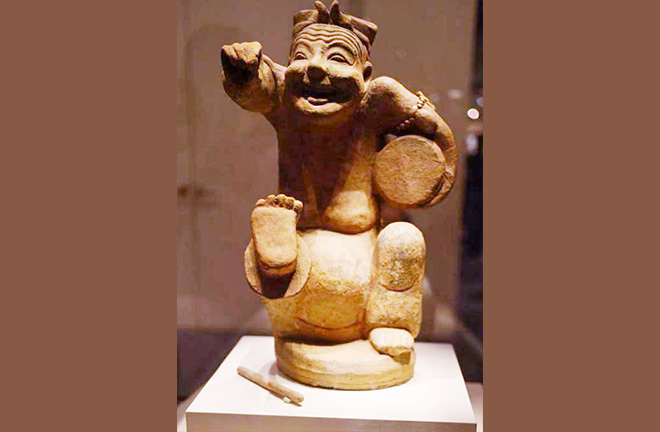Seminar presents historical culture of Han

Eastern Han Dynasty pottery statue of a story-teller beating a drum, displayed at the National Museum of China in Beijing Photo: Yang Lanlan/CSST
The Symposium on Han Dynasty Historical Culture and Regional Society was held in Ganzhou, Jiangxi Province, on Nov. 9.
Cultural transformation
The Han Dynasty (202 BCE–220 CE) was a crucial period for the establishment and development of China’s national artistic style. Xu Weimin, a professor from the School of Cultural Heritage at Northwest University, highlighted the significant progress made in Han painting compared to pre-Qin (prior to 221 BCE) art. Remarkable achievements were made in composition, line-drawing techniques, image depiction, expression methods, and the use of color. These works, which demonstrated the romantic characteristics of Chu-Han culture, were prominently featured in palace architecture and tombs. Han paintings are noted for their rich content, full compositions, and fluid lines, exuding a blend of romanticism and realism characteristic of the era. The Han tradition of elaborate burials has preserved this artistic legacy, with discoveries of mural tombs, stone reliefs, and tombs decorated with brick reliefs providing valuable insights.
“Influenced by local natural geographical conditions and cultural factors, the brick relief of southern Jiangxi incorporates elements of indigenous culture, displaying a distinct regional style,” explained Zhong Qinglu, an associate research librarian at the National Museum of Ganzhou. Excavations of Eastern Han tombs in the region have uncovered intricately designed brick reliefs that primarily depict scenes illustrating the tomb owners’ social status, visitations, daily life, banquets, travel, and other activities. A smaller number of bricks depict animal motifs, offering a vivid glimpse into the lives and burial customs of people living in southern Jiangxi during the Eastern Han period. The brick reliefs excavated from Han tombs in southern Jiangxi visually and vividly reveal the evolution of funerary customs, which were closely associated with Han military expeditions against the Baiyue people and the southward migration of northern populations. The shapes and structures of tombs, as well as the artistic styles, carving techniques, decoration, and symbolic meanings of the brick reliefs were all influenced by the traditional burial concepts of the Han ethnic group.
Bu Xiangwei, a professor from the Qi Culture Research Institute at Shandong University of Technology, stated that from the perspective of the “monarch-minister-subject” relationship, the social transformations during the Han and Tang (618–907) periods included the formation and eventual disintegration of aristocratic clans, the transition from a nobility-based political system to an autocratic monarchy, and the replacement of hereditary elites with public elites. During this period, traditional Chinese culture gradually evolved from intellectually classical forms toward a set of codified social norms, presenting a transition from civilian to aristocratic culture.
The spatial structure of Han Dynasty villages featured a dual layout combining residential spaces with burial spaces. Ma Xin, a professor from the School of History at Shandong University, explained that ancestral graves, an indispensable part of the village layout, represented the spiritual focus of agrarian society and the roots of villagers. This arrangement aligned with the system of inheritance among male descendants, reinforcing patriarchal kinship ties and fostering the development of clans, which further deepened the connection to the native land. Han Dynasty cemeteries expanded both above and below ground. Alongside the continued use of “pit tombs,” two innovative types of burial structures emerged—cave graves and chambered tombs.
Marquis of Haihun
Wu Fanglang, a research fellow at the Jiangxi Han Dynasty Culture Research Center, stated that over 10,000 artifacts were unearthed from the tomb of the Western Han Dynasty’s Marquis of Haihun. These items can be categorized by function into sacrificial vessels, ritual objects, daily utensils, and burial goods. The daily necessities encompass all aspects of the marquis’ everyday life, excluding clothing, such as dining, living, entertainment, culture, and travel. These exquisitely crafted artifacts also offer a glimpse into the advanced craftsmanship of the time, providing vivid historical resources for a deeper understanding of the development of the handicraft economy during the mid-Western Han period.
“The unearthed artifacts serve as direct clues to understanding the life philosophy of Liu He, the first Marquis of Haihun,” said Zhao Yibo, director of the Archaeology Department at the Nanchang Relic Museum for the Haihun Principality of the Han Dynasty. The dragon, cloud, and bird motifs on lacquerware unearthed from the Marquis’ vassal state not only highlight Liu He’s political status but also illustrate the lifestyles of the aristocracy of the period. These lacquerware pieces, primarily in red and black with gilding and silver inlay, showcase the identity and status of the ruling class while embodying the artistic and humanistic beauty of lacquer art from the Marquis of Haihun’s domain. Additionally, the rich textual materials found provide a deeper understanding of Liu He’s reverence for and continuation of Confucian thought, offering significant insights into the social fabric of the era.
Zhao Ming, a professor from the School of History, Culture, and Tourism at Jiangxi Normal University, noted that the Marquis of Haihun’s vassal state lacked a centralized fief. Instead, it relied on “field taxes” from households in six counties, including Haihun and Qiaoyang. The territorial borders of the vassal state were highly uncertain. Furthermore, the vassal state’s administrative system was informal, as no official appointments were made, there were no dedicated governmental offices or staff, and many of the marquis’ household affairs were managed by lower-ranking officials.
Edited by YANG LANLAN
